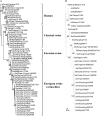Emergence of European avian influenza virus-like H1N1 swine influenza A viruses in China
- PMID: 19553585
- PMCID: PMC2725678
- DOI: 10.1128/JCM.00262-09
Emergence of European avian influenza virus-like H1N1 swine influenza A viruses in China
Abstract
During swine influenza surveillance from 2007 to 2008, 10 H1N1 viruses were isolated and analyzed for their antigenic and phylogenetic properties. Our study revealed the emergence of avian-origin European H1N1 swine influenza virus in China, which highlights the necessity of swine influenza surveillance for potential pandemic preparedness.
Figures


References
-
- Campitelli, L., I. Donatelli, E. Foni, M. R. Castrucci, C. Fabiani, Y. Kawaoka, S. Krauss, and R. G. Webster. 1997. Continued evolution of H1N1 and H3N2 influenza viruses in pigs in Italy. Virology 232310-318. - PubMed
-
- Chen, Y. J., H. Y. Li, Z. Y. Shen, H. L. Chen, K. Z. Yu, and Y. Z. Bi. 2005. Molecular evolution of hemagglutinin gene of H1N1 subtype swine influenza viruses isolated from the mainland of China. Chin. J. Prev. Vet. Med. 113-17.
-
- Cong, Y. L., J. Pu, Q. F. Liu, S. Wang, G. Z. Zhang, X. L. Zhang, W. X. Fan, E. G. Brown, and J. H. Liu. 2007. Antigenic and genetic characterization of H9N2 swine influenza viruses in China. J. Gen. Virol. 882035-2041. - PubMed
-
- Gregory, V., M. Bennett, Y. Thomas, L. Kaiser, W. Wunderli, H. Matter, A. Hay, and Y. P. Lin. 2003. Human infection by a swine influenza A (H1N1) virus in Switzerland. Arch. Virol. 148793-802. - PubMed
Publication types
MeSH terms
Substances
Associated data
- Actions
- Actions
- Actions
- Actions
- Actions
- Actions
- Actions
- Actions
- Actions
- Actions
- Actions
- Actions
- Actions
- Actions
- Actions
- Actions
- Actions
- Actions
- Actions
- Actions
- Actions
- Actions
- Actions
- Actions
- Actions
- Actions
- Actions
- Actions
- Actions
- Actions
- Actions
- Actions
- Actions
- Actions
- Actions
- Actions
- Actions
- Actions
- Actions
- Actions
- Actions
- Actions
- Actions
- Actions
- Actions
- Actions
- Actions
- Actions
- Actions
- Actions
- Actions
- Actions
- Actions
- Actions
- Actions
- Actions
- Actions
- Actions
- Actions
- Actions
- Actions
- Actions
- Actions
- Actions
- Actions
- Actions
- Actions
- Actions
- Actions
- Actions
- Actions
- Actions
- Actions
- Actions
- Actions
- Actions
- Actions
- Actions
- Actions
- Actions
- Actions
- Actions
LinkOut - more resources
Full Text Sources
Medical

